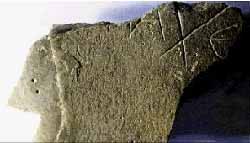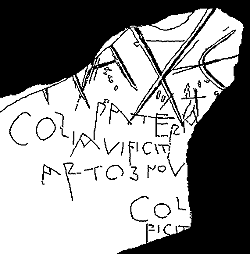
EBK Home
Kingdoms
Royalty
Saints
Pedigrees
Archaeology
King Arthur
Mail David
ARTHURIAN INSCRIPTION
FOUND AT TINTAGEL
 A
small piece of slate was discovered during excavations on Tintagel Island
inscribed with the name "Artognov". Is this the first real proof
of King Arthur's existence? Was
he really born at Tintagel as legend insists?
A
small piece of slate was discovered during excavations on Tintagel Island
inscribed with the name "Artognov". Is this the first real proof
of King Arthur's existence? Was
he really born at Tintagel as legend insists?
On 6th August 1998, English Heritage revealed that during the last week of digging on the Eastern terraces of Tintagel Island, a broken piece of Cornish slate (8" by 14") was discovered bearing the name "Artognov". It was excavated on July 4th, by Kevin Brady, an archaeologist working with a team from Glasgow University. "As the stone came out, when I saw the letters A-R-T, I thought uh-oh..."
The stone apparently bears two inscriptions. The upper strongly incized letters have been broken off and are sadly indecipherable. The lower inscription, though fainter, clearly reads "Pater Coliavificit Artognov", which Professor Charles Thomas of Exeter University has carefully translated as "Artognou, father of a descendant of Coll, has had this built". Possibly written by a Gaulish hand, the style of writing is certainly 6th century, a date confirmed by surrounding fragments of 6th century Mediterranean pottery already well known from the Tintagel site. Also found nearby was the remains of the only Spanish glass flagon known from this period of Britain's history. Chris Morris, who has been leading the Scottish based excavation team for the past eight years, believes that the dedicatory "Arthur Stone," as it has already been christened, was placed in the wall of a 6th century stone building which later collapsed soon after it was built. The slate was then reused as drain cover a century later.
 Though
"Artognou," pronounced "Arthnou," proves that names
similar to that of the great King existed in the, so called, Arthurian
period, Chris Morris is sceptical about making too much of the obvious
link with King Arthur's traditional birthplace. He believes the stone's
importance lies in the fact that it is "the first evidence we have
that the skills of reading and writing were handed down in a non-religious
context". However, Dr Geoffrey Wainwright, chief archaeologist at
the, normally cautious, English Heritage declared the newly discovered
link should not be dismissed. "Tintagel has presented us with
evidence of a Prince of Cornwall, in the Dark Ages, living in a
high-status domestic settlement at the time Arthur lived. It has given us
the name of a person, Arthnou. Arthnou was here, that is his name on a
piece of stone. It is a massive coincidence at the very least. This is
where myth meets history. It's the find of a lifetime."
Though
"Artognou," pronounced "Arthnou," proves that names
similar to that of the great King existed in the, so called, Arthurian
period, Chris Morris is sceptical about making too much of the obvious
link with King Arthur's traditional birthplace. He believes the stone's
importance lies in the fact that it is "the first evidence we have
that the skills of reading and writing were handed down in a non-religious
context". However, Dr Geoffrey Wainwright, chief archaeologist at
the, normally cautious, English Heritage declared the newly discovered
link should not be dismissed. "Tintagel has presented us with
evidence of a Prince of Cornwall, in the Dark Ages, living in a
high-status domestic settlement at the time Arthur lived. It has given us
the name of a person, Arthnou. Arthnou was here, that is his name on a
piece of stone. It is a massive coincidence at the very least. This is
where myth meets history. It's the find of a lifetime."
Chris Morris hopes to return next year and excavate the building from which the mysterious stone came. Will there be more of the inscription? The local Cornishmen certainly hope so.
EBK Comments
Despite the usual caution displayed on the part of the archaeologists, whether Artognou was the real King Arthur or not, surely there can be little doubt that he is the man responsible for Tintagel's associations with the Great King. For a man's name to have remained associated with a place for almost exactly 1,500 years seems remarkable; but if it happened in Greece and Rome, why not in Britain?
So what about this "Prince of Cornwall" then: who was he, if not the great man himself? The siting of a Royal stronghold at Tintagel would certainly suggest the court of a King of Dumnonia, and Arthur is indeed said by some to descend from this family. The inscription, however, would indicate that Artognou was a descendant of the historical late 4th century Celtic Royal ancestor, King Coel Hen (the Old). Coel lived in the North of Britain where his descendants ruled until mid-7th century. The Royal Line of Dumnonia was only descended from him in the female line during King Cado's generation. Traditionally Arthur was the cousin of Cado's father, though perhaps this Arthur-Artognou was a closer relative. It was not unknown for Celtic Kingdoms to be shared amongst joint-ruling brothers, rather than have the land divided. It is recorded in the Life of St.Carannog that Arthur ruled in Dumnonia, around Dunster, as the junior colleague of Cado. Could it be that the two were brothers, nominally ruling Dumnonia together but Arthur having his stronghold in the West at Tintagel while Cado held sway in the East from Dunster?
Link to: Excavation Details from Glasgow University.
